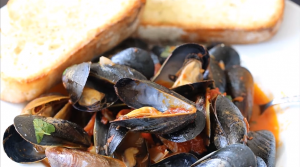Embark on a culinary journey with this flavorful Portuguese Clam and Chorizo Stew. This traditional dish is a perfect blend of savory chorizo, fresh clams, and the unique aroma of piquillo peppers. It's a hearty and satisfying stew that brings the essence of Portuguese cuisine right to your dinner table.
While most ingredients are common in most households, there are a few you need to be cautious about when heading to the supermarket. The main protagonist of our dish, Chorizo, is a flavorful Spanish sausage that can be found in most deli sections. Littleneck clams are a type of small clam, widely available at seafood counters. Piquillo peppers, with their sweet, slightly spicy flavor, might be located in the international aisle. Lastly, 'peasant bread' refers to any rustic, hearty bread with a thick crust.
Ingredients for Portuguese Clam and Chorizo Stew
Chorizo: A Spanish sausage made from pork, it's seasoned with smoked paprika giving it a distinctive flavor and color.
Chicken stock: A flavorful liquid made by simmering chicken bones and vegetables, used as a base for soups and stews.
Peasant bread: A type of rustic, hearty bread that pairs perfectly with the robust flavors of the stew.
Extra-virgin olive oil: Made from pure, cold-pressed olives, it provides a fruity note.
Garlic: Used for its distinctive flavor, it's a key ingredient in Portuguese cuisine.
Bacon: Adds a smoky, meaty flavor to the stew.
Onion: Adds a savory depth to the dish.
Piquillo peppers: Small, sweet, and slightly spicy, these peppers add a unique flavor.
Littleneck clams: Small, hard-shell clams which are tender and sweet, they are the heart of the stew.
One reader, Hilarius Freund says:





This Portuguese clam and chorizo stew recipe is a game-changer! The flavors are rich and comforting, and the combination of chorizo and clams is simply divine. The dish is easy to prepare and perfect for a cozy night in. I highly recommend trying it out for a delightful culinary experience.
Techniques for Perfecting Portuguese Clam and Chorizo Stew
Preheat the oven to 350 degrees F: This step is essential to ensure the oven is at the correct temperature for toasting the bread.
Simmering the chorizo: Simmer the chorizo in chicken stock for about 15 minutes until softened. This helps to infuse the chorizo with flavor and ensure it is cooked through.
Toasting the bread: Brush the bread with olive oil and toast for about 10 minutes until golden. This step adds a delicious crunch and flavor to the bread.
Rubbing the toasts with garlic: Rubbing the toasts with a peeled whole garlic clove adds a subtle garlic flavor to the bread, enhancing the overall dish.
Cooking the bacon: Cooking the bacon until crisp adds a savory and smoky flavor to the stew.
Cooking the onion and garlic: Cooking the onion and minced garlic until softened helps to build a flavorful base for the stew.
Adding the piquillo peppers: Adding the piquillo peppers and their liquid infuses the stew with a sweet and smoky flavor.
Cooking the clams: Cooking the clams with the stew until they open ensures they are cooked through and ready to be enjoyed.
Serving the stew: Spooning the stew over the toasts, drizzling with olive oil, and serving right away ensures the dish is presented at its best.
How To Make Portuguese Clam and Chorizo Stew
This remarkable Portuguese Clam and Chorizo offers a savory adventure with bacon, garlic, and an added hot and bittersweet hint from piquillo peppers.
Serves:
Ingredients
- ½lbchorizo
- 1½cupschicken stock,or low-sodium broth
- 6peasant bread,thick slice
- ¼cupextra-virgin olive oil
- 3cloveslarge garlic
- ¼lbbacon,thickly sliced
- 1very large onion
- 8ozpiquillo peppers,(1 can or jar)
- 48littleneck clams
Instructions
-
Preheat the oven to 350 degrees F.
-
Put the chorizo in a small saucepan with 1 cup of the stock and simmer for about 15 minutes until softened.
-
Drain the chorizo and discard the broth.
-
Meanwhile, brush the bread with olive oil and toast for about 10 minutes, until golden.
-
Rub the toasts with the peeled whole garlic clove, and transfer each slice to a deep soup bowl.
-
In a large enameled cast-iron casserole, heat 2 tablespoons of olive oil until shimmering.
-
Add the bacon and cook over moderate heat for 7 to 8 minutes, stirring, until crisp.
-
Using a slotted spoon, transfer the bacon to a plate and reserve it for another use.
-
Add the onion and minced garlic to the casserole and cook over low heat for about 5 minutes until softened.
-
Add the piquillo peppers and their liquid, and cook for 1 minute.
-
Add the chorizo and the remaining ½ cup of stock and bring to a boil.
-
Add the clams, cover, and cook over high heat for about 10 minutes until nearly all have opened.
-
Discard any unopened clams.
-
Spoon the stew over the toasts, drizzle with the remaining 2 tablespoons of olive oil, and serve right away
Nutrition
- Calories: 1498.28kcal
- Fat: 45.34g
- Saturated Fat: 12.62g
- Trans Fat: 0.14g
- Monounsaturated Fat: 19.64g
- Polyunsaturated Fat: 9.62g
- Carbohydrates: 199.05g
- Fiber: 16.48g
- Sugar: 25.82g
- Protein: 71.95g
- Cholesterol: 82.34mg
- Sodium: 3328.36mg
- Calcium: 575.87mg
- Potassium: 1096.67mg
- Iron: 16.36mg
- Vitamin A: 113.88µg
- Vitamin C: 33.91mg
Expert Tip for Enhancing the Flavors of Portuguese Clam and Chorizo Stew
When preparing the clams, make sure they are properly cleaned before adding them to the stew. Any grit or sand left on the clams can end up in your stew, affecting the overall texture and flavor. To clean them, simply place the clams in a bowl of cold water with a bit of salt. The clams will naturally filter out the sand and grit. Rinse them under cold water before cooking. This will ensure a smooth and flavorful Portuguese clam and chorizo stew.
Time-Saving Tips for Portuguese Clam and Chorizo Stew
Prep ahead: Chop and measure all ingredients in advance to streamline the cooking process.
Use pre-cooked chorizo: Save time by using pre-cooked chorizo, which eliminates the need for additional cooking time.
Multi-task: While the chorizo is simmering, prepare the other ingredients to maximize efficiency.
Quality ingredients: Opt for high-quality, pre-sliced chorizo and pre-cooked bacon to reduce prep time.
Organize your workspace: Keep your workspace organized and clean to work more efficiently and prevent any unnecessary delays.
Efficient cooking equipment: Utilize efficient cooking equipment, such as a cast-iron casserole, to ensure even cooking and save time.
Quick toasting: Use a toaster to quickly toast the bread slices instead of toasting them in the oven.
Substitute Ingredients For Portuguese Clam and Chorizo Stew Recipe
chorizo - Substitute with linguiça: Linguiça is a Portuguese sausage similar to chorizo, but with a slightly different flavor profile. It can be used as a substitute in this recipe to maintain the smoky and spicy elements.
chicken stock - Substitute with vegetable stock: Vegetable stock can be used as a substitute for chicken stock to make the dish vegetarian-friendly while still providing a flavorful base for the stew.
peasant bread - Substitute with French baguette: French baguette can be used as a substitute for peasant bread to provide a crusty and hearty texture to soak up the flavorful stew.
extra-virgin olive oil - Substitute with avocado oil: Avocado oil can be used as a substitute for extra-virgin olive oil, providing a mild and buttery flavor to the stew.
garlic - Substitute with shallots: Shallots can be used as a substitute for garlic to provide a milder and slightly sweet flavor to the stew.
bacon - Substitute with pancetta: Pancetta can be used as a substitute for bacon to provide a similar smoky and salty flavor to the stew.
onion - Substitute with leeks: Leeks can be used as a substitute for onions, providing a milder and slightly sweeter flavor to the stew.
piquillo peppers - Substitute with roasted red bell peppers: Roasted red bell peppers can be used as a substitute for piquillo peppers, providing a similar sweet and smoky flavor to the stew.
littleneck clams - Substitute with mussels: Mussels can be used as a substitute for littleneck clams, providing a similar briny and seafood flavor to the stew.
Presentation Tips for a Delightful Clam and Chorizo Stew
Elevate the bread: Toast the peasant bread until golden, then brush with extra-virgin olive oil and rub with garlic for a flavorful base to the stew.
Create a stunning visual: Arrange the clams and chorizo stew over the garlic-rubbed toasts in a deep soup bowl for an elegant and appetizing presentation.
Emphasize the freshness of the clams: Ensure that the clams are arranged attractively on top of the stew, showcasing their natural beauty and freshness.
Highlight the vibrant colors: The piquillo peppers add a pop of color to the stew, creating a visually appealing dish. Ensure they are evenly distributed for a balanced presentation.
Drizzle with olive oil: Finish the dish with a drizzle of extra-virgin olive oil for a glossy sheen and a touch of richness.
Attention to detail: Carefully discard any unopened clams before serving to ensure a flawless and professional presentation.
Use high-quality serving ware: Select elegant and sophisticated bowls or plates to showcase the Portuguese clam and chorizo stew, adding a touch of luxury to the presentation.
Garnish with fresh herbs: Sprinkle the stew with finely chopped parsley or cilantro to add a burst of color and a hint of freshness to the dish.
Essential Kitchen Tools for Making Portuguese Clam and Chorizo Stew
- Saucepan: A deep cooking vessel with a handle and a lid, used for heating and cooking ingredients such as the chorizo and chicken stock.
- Oven: A kitchen appliance used for baking and toasting, as in the case of toasting the bread slices.
- Small saucepan: A smaller version of a saucepan, used for simmering the chorizo with the chicken stock.
- Cast-iron casserole: A heavy-duty, large pot with a tight-fitting lid, used for cooking the stew over the stovetop.
- Slotted spoon: A spoon with slots or holes that allow liquid to pass through, used for transferring the cooked bacon from the casserole.
Storing and Freezing Portuguese Clam and Chorizo Stew
- Let the portuguese clam and chorizo stew cool completely to room temperature before storing or freezing.
- Transfer the cooled stew to an airtight container or a heavy-duty freezer bag, leaving about an inch of space at the top for expansion during freezing.
- If using a container, make sure to press a piece of plastic wrap directly onto the surface of the stew to prevent freezer burn.
- Label the container or freezer bag with the date and contents.
- For storing in the refrigerator: Place the sealed container in the refrigerator for up to 3-4 days.
- For freezing: Place the sealed container or freezer bag in the freezer for up to 2-3 months.
- To reheat, transfer the frozen stew to the refrigerator and let it thaw overnight.
- Once thawed, transfer the stew to a pot and reheat it gently over medium-low heat, stirring occasionally, until it is heated through and the clams are warm. Avoid boiling the stew, as this can cause the clams to become tough and rubbery.
- If the stew seems too thick after reheating, you can add a little chicken stock or water to thin it out to your desired consistency.
- Serve the reheated stew hot, garnished with fresh herbs like chopped parsley or cilantro, and enjoy with crusty bread for dipping.
How to Reheat Leftover Portuguese Clam and Chorizo Stew
Reheat the stew in a large pot or Dutch oven over medium-low heat, stirring occasionally, until it reaches a simmer. This gentle reheating method helps preserve the texture of the clams and prevents the chorizo from becoming tough.
If the stew seems too thick, add a splash of chicken stock or water to thin it out and help distribute the heat evenly.
Alternatively, you can reheat individual portions in the microwave. Place the desired amount of stew in a microwave-safe bowl, cover it with a damp paper towel, and heat it in 30-second intervals, stirring between each interval, until it's heated through.
To reheat the bread, wrap it in foil and place it in a preheated 350°F (175°C) oven for about 10 minutes, or until it's warmed through and crispy on the outside.
If you have any leftover piquillo peppers, you can add them to the stew during the reheating process to enhance the flavor and texture.
For a crispy texture, you can also reheat the stew in a covered skillet over medium heat until it's bubbling, then remove the lid and continue cooking for a few more minutes to allow some of the liquid to evaporate and the flavors to concentrate.
If you want to add some freshness to the reheated stew, garnish it with chopped parsley or cilantro before serving.
Interesting Trivia About Portuguese Clam and Chorizo Stew
The Portuguese clam and chorizo stew is a traditional dish from the coastal regions of Portugal. It combines the rich flavors of chorizo with the briny taste of fresh clams, creating a hearty and satisfying stew. This dish is often enjoyed with crusty peasant bread, which is perfect for soaking up the flavorful broth. The use of piquillo peppers adds a touch of sweetness and smokiness to the stew, enhancing its depth of flavor. This dish is a perfect representation of the vibrant and diverse culinary heritage of Portugal, showcasing the country's love for fresh seafood and bold, aromatic ingredients.
Budget-Friendly: Is Portuguese Clam and Chorizo Stew Economical?
This Portuguese clam and chorizo stew recipe offers a delightful blend of flavors and textures, making it a worthwhile addition to your culinary repertoire. The use of chorizo and clams provides a rich and savory profile, while the addition of piquillo peppers lends a subtle sweetness. The dish is relatively cost-effective, with the main ingredients being readily available. The approximate cost for a household of four people is around $25, making it a budget-friendly option. Overall Verdict: 9/10
Is Portuguese Clam and Chorizo Stew Healthy?
The Portuguese clam and chorizo stew recipe is a flavorful dish, but it may not be the healthiest option due to several ingredients high in saturated fat and sodium. The chorizo, bacon, and olive oil contribute to the dish's high fat content, while the chorizo, bacon, and chicken stock add significant amounts of sodium. However, the recipe also includes some nutritious ingredients, such as onion, garlic, and clams, which provide essential vitamins, minerals, and lean protein.
To make this recipe healthier:
- Reduce the amount of chorizo and bacon or replace them with leaner protein sources like chicken or turkey sausage
- Use a low-sodium chicken stock to decrease the overall sodium content
- Increase the number of vegetables in the stew, such as adding diced tomatoes, bell peppers, or zucchini to boost the dish's fiber and nutrient content
- Replace some of the olive oil with a lower-fat cooking method, such as sautéing the onions and garlic in a small amount of oil or using cooking spray
- Serve the stew with a side salad or steamed vegetables to balance the meal and add more nutrients
Editor's Opinion on This Delectable Portuguese Stew
The Portuguese clam and chorizo stew recipe is a delightful blend of flavors and textures. The combination of chorizo, bacon, and clams creates a rich and savory base, while the piquillo peppers add a hint of sweetness and smokiness. The use of peasant bread as a base provides a comforting and rustic element to the dish. The recipe's method of toasting the bread and rubbing it with garlic adds a lovely aromatic touch. Overall, this stew is a wonderful representation of Portuguese cuisine, with its bold and robust flavors. It's a dish that is sure to impress and satisfy any seafood lover.
Enhance Your Portuguese Clam and Chorizo Stew Recipe with These Unique Side Dishes:
Similar Recipes to Try If You Love Portuguese Clam and Chorizo Stew
Appetizer and Dessert Ideas to Complement Portuguese Clam and Chorizo Stew
Why trust this Portuguese Clam and Chorizo Stew Recipe:
This Portuguese Clam and Chorizo Stew recipe is a trusted classic, featuring chorizo and clams that bring a burst of savory flavors. The combination of piquillo peppers and bacon adds depth and richness to the dish. With a base of chicken stock and a touch of extra-virgin olive oil, this recipe promises an authentic taste of Portugal. The careful instructions ensure a delightful outcome, making it a reliable choice for anyone seeking a taste of traditional Portuguese cuisine.
Was this page helpful?
Have your own special recipe to share? Submit Your Recipe Today!













